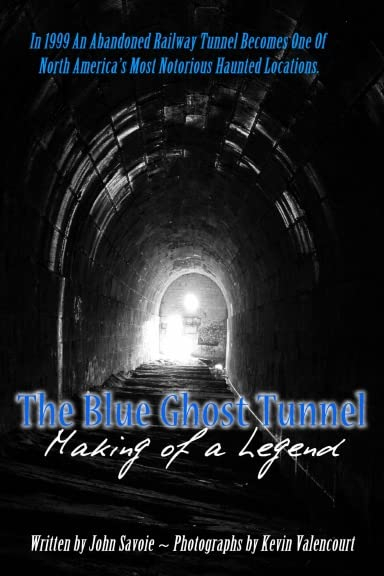
Reviewed by Tom Ruffles
The Merritton Tunnel, more dramatically known as the Blue Ghost Tunnel (BGT), is in the Niagara region of Southern Ontario. It is often considered to be the most haunted place in Canada, and a considerable volume of myth and folklore has grown up around it. Thanks to its reputation, enormous crowds have visited expecting paranormal activity, and the consequent necessity to separate facts from spurious accretions renders serious investigation difficult.
John Savoie has been researching the location for many years. He traces its history from working tunnel through disuse to fame as a paranormal hot-spot, documenting the sad physical decline, natural decay abetted by vandalism; it is now considered a dangerous structure, one end is flooded and it has been fenced off. It’s a complicated story, but the inclusion of a large number of photographs and maps helps to orient the reader unfamiliar with the saga or the topography.
The single-track tunnel, built to pass under a canal, opened in 1881 and closed in 1915, superseded by a double-track swing-bridge. It was first investigated as a haunted site in the 1970s, but its reputation grew enormously from 1999, after a paranormal investigator coined the ‘Blue Ghost’ tag as a result of witnessing a “blue, fog-like apparition” – possibly his breath. Despite a lack of experience (he was a teenager), he made bold claims for paranormal activity via the internet, which spread the BGT’s reputation much further and faster than would have happened in the old days, demonstrating the speed with which memes can circulate and mutate with very little in the way of decent evidence to support them. We can see the narrative developing, and have a record of it.
What really seems to have made the BGT what it is today is an appearance on a paranormal TV show called Creepy Canada. This boomed the location as “700 ft of Hell on Earth!” so it is not surprising that it attracted a certain set with fixed expectations. Interest after the broadcast increased enormously via social networking sites, making the tunnel a victim of its own success. Visiting the tunnel, which belongs to the Seaway Authority, necessitates trespassing, but this did not deter thrill-seekers. How much serious psychical research went on is unclear and it became a magnet for partying youths as well as paranormal investigators possessing varying degrees of competence and contact with reality.
Not having much in the way of direct links to a paranormal aetiology itself, various tragedies in the area became associated with the tunnel, even if not directly related to it, creating a metaphorical black hole which sucked in those events to augment its reputation. Added to such speculations were wild assertions that were patently overoptimistic, and occasionally faked. Some ghost hunters were interested primarily in personal aggrandisement, preferring to focus more on potential media deals than in seeking the truth.
The BGT is thus a microcosm of all that is best and worst, but mostly worst, in paranormal research. Savoie evaluates the various accounts that have accumulated around the BGT, considers whether there might be any truth in them, and looks at possible explanations for people’s experiences. Apart perhaps from some dotting and crossing, it is unlikely that much of substance will be added to his study. Clearly at some point the tunnel is going to collapse, but even then one suspects that the location will continue to exert a fascination, and attract further unreliable tales.

